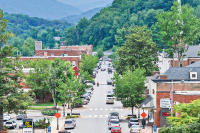Steep slope redux: A pocket guide to proposed revisions in Jackson’s steep slope ordinance
 Limits on mountainside development and standards for steep slope building are once again in the spotlight in Jackson County.
Limits on mountainside development and standards for steep slope building are once again in the spotlight in Jackson County.
The Jackson County planning board has spent the past 14 months rewriting steep slopes regulations first put in place seven years ago.
They were more restrictive than anywhere else in the mountains at the time. The watered-down version that has emerged from the rewrite is still far more protective than most mountain counties.
The steep slope hearing scheduled for Thursday, Feb. 13 has been moved to Thursday, Feb. 20.
Nonetheless, the proposed revisions would pave the way for more permissive development on mountainsides.
Related Items
MORE: What's In | What's Out
The original steep slope rules were an about-face to the laissez-fare, Wild West development days of the previous decade. Public outcry over the unchecked, speculative buy-up of mountain land drove the creation of Jackson’s first steep slope ordinance in 2007.
But with real estate sales languishing in these post-recession doldrums, the current debate lacks the fury and passion that surrounded the initial ordinance, when public hearings drew hundreds on both sides.
The steep slope revisions are the third and final installment in a trilogy of rewrites to Jackson County’s development regulations. The subdivision ordinance and open space ordinance were on the docket last year.
Both of those were loosened as well, with changes already finalized. The steep slope ordinance was saved for last. It was the most controversial when initially put in place and is poised to be the most controversial as the rewrites head for passage.
This is the second in a two-part series on the steep slope rewrite. For last week’s article, go to www.smokymountainnews.com.
This week, see what got cut and what stayed in the proposed revisions. The rewrite isn’t final yet. County commissioners hold the final vote, which is still at least several weeks away.
It’s important to note that existing lots and developments are exempt from parts of the steep slope ordinance. Some criteria here would be impossible to comply with given the confines of existing lot lines, and thus wouldn’t apply. All new lots created in the future would have to be laid out with the ordinance in mind, however, and followed when built on.
What’s in: Things the board left in during its rewrite
Engineer oversight for homes on steeper slopes or problem soils
What the old ordinance said: An engineer must sign off on soil stability when county soil maps indicate “problematic soils,” which incidentally is most of the county. Once a slope hits 40 percent or more, or in cases where an engineer was unable to certify soil stability, additional oversight is triggered — namely, an assessment and certification by a geotechnical engineer and a hydrological control plan.
Why it’s still in: As slope increases, so do soil stability concerns, prompting the need for builders to engage an engineer or geotechnical engineer.
Rest of the story: For development activity other than a single-family home, such as subdivision design approval, the requirement for a geotechnical engineer and a hydrological control plan kicks in once slopes hit 35 percent.
Partial screening of homes with trees
What the old ordinance said: Mountainside homes should be screened with trees, shielding at least 50 percent of the face of the building from view.
Why it’s still in: Homeowners can still achieve views from their homes by limbing out trees to create view “windows” and cutting down some trees, but it prevents the wholesale removal of trees along the entire length of the house, in an effort to protect the appearance of the mountainside as seen by others. This is the only measure aimed purely at aesthetics that got left in.
Rest of the story: If there isn’t existing vegetation to accomplish screening, trees must be planted.
Cut and fill slopes
What the old ordinance said: Cut slopes cannot be steeper than a ratio of 1:1 (horizontal run to vertical rise) and fill slopes cannot be steeper than 1.5:1.
Why it’s still in: This threshold ensures stability of excavated slopes.
Rest of the story: Steep cuts and fills are prone to slipping. Fill slopes by nature are less stable and thus can’t be as steep as cut slopes.
Benching
What the old ordinance said: Cut-and-fill slopes had to be benched at intervals — akin to small stair steps or terraces — to make the slope more stable.
Why it’s still in: It’s a safety thing.
Rest of the story: The new benching requirement is actually stronger than the old one. The old one required a bench every 35 feet vertically. The new one requires a bench at 10-foot intervals on cut-and-fill slopes exceeding 20 feet in vertical height. But there is an automatic exemption from the benching requirement if the cut-and-fill slope has the seal of approval from a certified engineer.
The new language also added a provision that the height of a combined cut-and-fill slope can’t exceed 60 vertical feet.
Compaction
What the old ordinance said: Fill slopes must be compacted.
Why it’s still in: It’s common sense. Fill slopes, where dirt carved out from one area is piled up in another area during the excavation process, tend to slip over time and can trigger landslides if not compacted.
What’s out: Things the board cut during its rewrite
Limit on number of mountainside homes
What the old ordinance said: The number of homes on steep slopes was capped, based on a sliding scale. The steeper the slope, the fewer homes allowed. Slopes of 30 percent could have only one house every two acres, while slopes of 45 percent or more could only have one house every 10 acres, with gradients in between.
Why it’s out: There was no overriding safety or environmental rationale. Its only purpose was aesthetics — namely fewer homes would be less obtrusive on the mountainside.
Rest of the story: Some argued there actually was a safety justification. More homes on a steep slope mean more disturbances, which increases the risk of landslides. And fewer homes also put less drain on the groundwater table that feeds wells.
Ridgetop construction
What the old ordinance said: Homes couldn’t be built on ridgetops. The roofline of a home had to be at least 20 feet below the ridgeline.
Why it’s out: This was deemed purely aesthetic, which wasn’t a legitimate justification in the eyes of the planning board. Further, some argued that a home on the side of a mountain requires more excavation and thus can sully views and have more environmental impact than building on the ridge itself, since some ridges have flat spots on top.
Rest of the story: This one prompted considerable debate over which would mar up a mountain more: building on a ridgetop or side of a slope? Once changed, the county can’t go back, at least under the latest state policy that prohibits local environmental rules that are stricter than the state’s own environmental rules.
Steep slope rules trigger
What the old ordinance said: The steep slope ordinance kicked in on slopes of 30 percent or more.
Why it’s out: Steep slope precautions aren’t necessary until the slope reaches 35 percent — which became the new threshold for when the ordinance kicks in.
Rest of the story: Steep slope rules apply to fewer areas than before.
Disturbance footprint
What the old ordinance said: For single-family homes, the grading envelope, a.k.a. disturbed area, was limited to a footprint of 10,000 square feet.
Why it’s out: It wasn’t done away with entirely, but the new disturbance limits are not nearly as strict. The grading envelope is now based on a sliding scale dependant on the slope, and as a percentage of the total lot size. Up to 20 percent of the lot can be disturbed on slopes of 35 percent, or 10 percent of the lot on slopes of 45 percent, with a gradient in between.
It allows for far more site excavation than the prior cap, but driveways do not count for the total allowed area.
Rest of the story: The original rule was intended to limit the amount of grading and excavation that occurs during construction — which in turn prevents erosion, preserves existing trees, improves slope stability and lessens visual scars. But the planning board felt the old rule was too restrictive and could limit the size of a house someone could build.
Impervious surfaces, a.k.a the part of the lot that’s paved over or built on
What the old ordinance said: It capped impervious surfaces at 6,000 square feet for single-family homes, not counting the driveway.
Why it’s out: It wasn’t done away with entirely, but the new limit on impervious surface is far more permissive. The larger the lot, the more impervious surface you can have, from 7,000 square feet on lots of 1 acre or less up to 15,000 square feet on lots of 10 acres or less.
Rest of the story: Limiting impervious surface was originally intended to stop runoff issues. Rain that hits roofs and patios doesn’t soak into the ground, but instead runs off down the mountain somewhere, and it is one of the main variables in landslides. Also, allowing the rain to soak in helps the groundwater table recharge.
But the planning board decided the impervious surface limits would hamper people from building a really big home with a large footprint if they so desired.
Best practices for building on steep slopes
What the old ordinance said: A suite of recommendations advised builders and developers on responsible and sustainable building practices, such as using earth-toned house colors, blending architecture with the natural topography, minimizing alterations of the land’s natural contours, protecting unique habitats, limiting tree removal and several others.
Why it’s out: They weren’t mandatory, and thus caused confusion.
Rest of the story: The county intends to create a separate “best practices” brochure to encourage sustainable building instead of imbedding them in the ordinance.
Want to weigh in?
A public hearing on revisions to Jackson County’s steep slope ordinance originally scheduled for 6 p.m. Thursday, Jan. 13, at the county administration building in Sylva, has been postponed due to a great big snow. It will now happen next Thursday, Feb. 20, same time and place.









